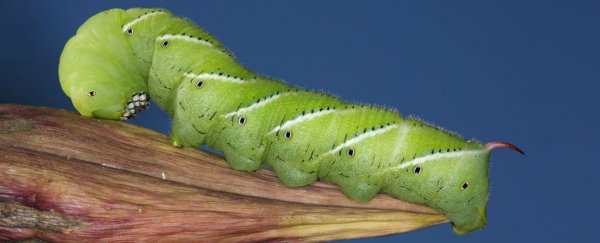Plants evolved thorns, prickles, and spines to avoid being chomped on by the sensitive lips and tongues of large mammals. At least, that's what we assumed.
In the face of conventional wisdom, researchers have discovered for at least some species of plant, growing spiky bits isn't just to discourage large herbivores; they can also protect their leaves from becoming a caterpillar's lunch.
Scientists from the Swiss Federal Institute of Technology Zurich and the University of North Carolina made the discovery while studying Carolina horsenettle plants (Solanum carolinense) in a previous experiment on plant inbreeding.
They noticed that the numbers of spines and hair-like structures called trichomes on the plant increased after being nibbled on by a moth larva called a tobacco hornworm (Manduca sexta).
"That made us think that these spines could also have [an] additional function than what we have been taught," ecologist Rupesh Kariyat told Christie Wilcox at Quanta Magazine.
For the record, while they might serve similar purposes, not all sharp parts of a plant are quite the same: thorns are derived from new shoots, spines are modified leaves, and prickles lack the vascular tissue of shoots and leaves, and are extensions of the epidermis.
(So if you really want to make friends and influence people, correct someone the next time they say roses have thorns by telling them they are actually prickles.)
While there is plenty of evidence showing that long spines deter larger herbivores from eating a plant, the idea that spines might put off something with a tiny mouth seemed somewhat preposterous.
Wouldn't the caterpillars just crawl straight over them? They sure did. Which, it turned out, was the secret to how the spines worked.
The researchers used a variety horsenettle that had few spines, stripping plants of all but their top leaves before timing how long it took caterpillars to race to the top. They did the same thing with a variety of horsenettle that grew more spines, and compared the times.
Next, they trimmed down the number of spines from the more spiky variety so they matched the smoother plants, and repeated the experiment.
Lastly, the researchers replaced the plants with related species with different densities of spine growth. In those trials the researchers timed how long it took for the tobacco hornworm larvae to eat all of the leaves.
In some trials the researchers replaced the caterpillars that fell from the leaves, while in others they left them to find their own way back up.
Not only did the spines interfere with their times, forcing the caterpillars to take longer to climb up the plants, they also made it harder for the tiny herbivores to hold on.
In fact, in trials where fallen caterpillars weren't returned to their leaves, plants without spines were stripped within a day, while those with spines were barely half-eaten.
The research shows that along with other forms of defence, spines can play a role in reducing the fitness of the caterpillars, making them more vulnerable to predators or even interfering with later developmental stages such as pupation.
None of this is to categorically state that the plants evolved the spines for the purpose of kicking off caterpillars.
Even the researchers think their discovery shows an added benefit, not a primary driver. "We think that spines evolved against mammalian herbivores," said Kariyat.
But the fact plant spikes might affect tiny consumers as well as big ones could help us understand how these defences developed in the first place.
Several plant species that sprouted on land during the Devonian period more than 400 million years ago had spines in spite of there being no large herbivores around to worry about.
While there is speculation that these ancient prickly parts might have helped increase surface area or provide some sort of support or cohesion, it's possible that they were also to keep creepy-crawlies down to a minimum.
Given so most of the current research on spiny plant defences is concerned with large animals, the study could stir up interest in how smaller herbivores are affected.
"If you look in the literature about spinescence in plants, there are about 150 to 200 papers about mammalian herbivory, but you see only two or three, maybe four, on insects," Kariyat told Wilcox.
Maybe it's time to look a lot closer at the little guy.
This research was published in Biology Letters.
